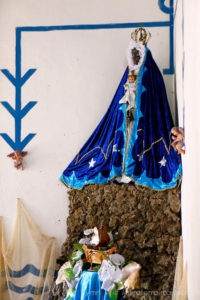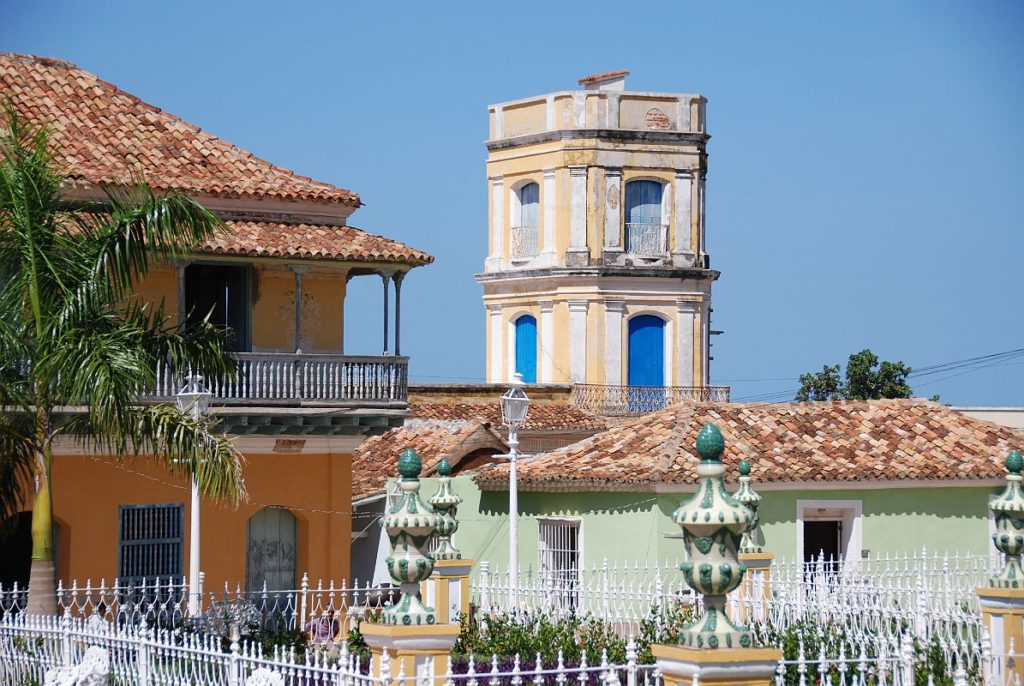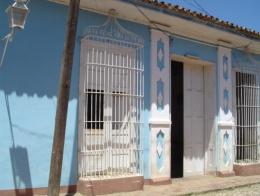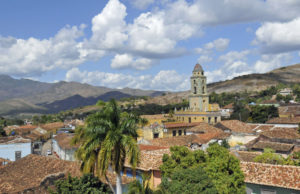This important building is located a few meters from Trinidad Plaza Mayor, on Calle Real del Jigüe between Desengaño and Boca, highlighted by the blue color of its façade by some white elements, in addition to the superb smithy that protects The walls of the patio that adjoin the street. Its historical, architectural and cultural importance lies in the duality of use as a religious temple and house dwelling at the same time, constituting a temple that reflects the most genuine and authentic values of Afro-Cuban culture and local identity.
The Temple arises according to the oral tradition from an Afro aboriginal burial found in the patio of this house consisting of spherulite stones, petaloid axes, original fishing elements of incalculable beauty, that belonged to slaves who inhabited the abode in previous centuries.
The word Afro Aboriginal is due to the fact that African practitioners found similarity in the elements that make up their garments with utensils used by Aborigines who lived in this area, the group of preceramistas or protoagricultores.
To the previous event are added the image of Yemaya belonging to the family that currently lives in the house, which when buying the same was in one of the rooms that served as shelter to the slaves. The image had a deplorable state so it was subjected to a process of restoration by the family.
It is dazzling for the visitors of this Afro-Cuban temple the allegorical paintings on the walls of its enormous room, in its center rests on a small chair a rag doll black or Anaquillé, that is used like symbol of protection or amulet. This little doll dressed in allegorical form of white invites to pass to the parlor where in one of its corners on a pedestal we appear the image of Yemayá.
The cloth rack was another form of having a likeness of a spirit or Orisha in his allegorical costumes, this one was represented and took religious values in the altars, it also represents an image that also participates in the festivals of the Temple, occupying a Important place inside the Plaza, receiving offerings like sweets, flowers, fruits, candles just like the other Orishas.
In the second cradle was erected an altar that has the image of the Virgin of Regla as a symbol located in its center with a child Jesus in his arms, elegantly dressed in silver color covered with a blue layer of lace, on the head rests the elegant Crown of encrusted stones, on its feet rests the base that resembles the sea with its reefs, snails and other elements that are related to the figure. Its origin is in the catholic religion, recognized like Yemayá in the afro-cubana religion.
Originally the shopkeepers were nineteenth century showcases that were adapted to place in an orderly and logical manner the receptacles of the Orishas, as well as their attributes, in the nineteenth and twentieth centuries used showcases and cupboards where freed and Creole blacks kept their Orishas In amphorae and porcelain making fun of the church that existed at the time.
The casket of the Temple is a small cabinet of precious wood with glass door divided in different parts in each one of which the porcelain and allegorical elements of the santería are observed, above each one of them appears the representative necklace of its Orisha, Inside are kept stones and snails that are animistic, allegorical elements to the Orishas of natural phenomena.
Occupying an important place inside the Temple appears the spiritual table that owns seven glasses of waters that remain full and behind it a crucifix. The number seven according to oral accounts is because it is a kabbalistic number that means the seven African powers.
Another important place inside the Temple is the cauldron of the Warriors, in this they inhabit figuratively the Oggún Oggún and Ochosi, inside it has different elements elaborated with iron that identify these holy warriors like chains, horseshoes, logs, machetes That are of congo origin and symbolize the psychic force of Zarabanda syncretized in Cuba by San Pedro or San Felipe Santiago.
The ceremonies are nocturnal and are enlivened by the drumming (Bembé) occasionally performed with the foundation drums that is able to produce a loud and sharp sound, heard even in places very distant from the temple, the touch to the Orishas He realizes following a logical order beginning with Eleggúa considered the greater Orisha, the one that opens and closes the ways, soon they follow the others, closing the ceremony with another touch to this figure.
When a certain Orisha is played at the beginning of the drumbeat, the santeros who have received it in santo greet the drums, offer offerings and greet the brothers of religion. Then santeros and believers dance and dance to the rhythm of the touches that are made one after another to pay homage to the Orishas gods.
Then the main priest called Santero invokes the spirits and directs the ceremonies, in the dances and through the songs are called the Orishas where the believer either santero or aleyo can develop a special relation with a determined Orisha that can own the body of That during the worship, performing their dances, greeting those present, performing cleanings, emitting phrases in their peculiar language.
The procession of Yemaya is an important part of the local cultural heritage, as are those of Santa Bárbara and San Lázaro, constituting a momentous event where, with scarce resources, the roots of religion remain.
The house is located in the historical center, formerly Calle Real del Jigüe, between Desengaño and Boca, within a purely colonial environment characterized by buildings built between the XVIII and XIX centuries, very close to the Plaça del Jigue that served to celebrate the first mass Of Christmas, in 1513 and the Plaza Mayor considered as one of the most authentic, beautiful and charming of the city.

Trinidad. Santeria Altar to Yemaya, Goddess of the Sea, at Casa Templo de Santería Yemayá in Trinidad.
Although the precise date of manufacture of the house in the eighteenth century is not specified, it was destined from the beginning for housing and it was not until the end of the last century where its own inhabitants had the figure of the Virgin of Regla (Yemayá ) Then decided to change the fate of the old family building officiating as the temple house of Yemaya.
The use of color in the façade is very striking when combined with the white and blue columns that are attached to the entrance and the wall that protects the patio on the left side in the street, this singularity makes it one of the most Elegant and distinguished from the historical architectural environment.
FOLLOW US ON TWITTER AND FACEBOOK. THECUBANHISTORY.COM

EL TEMPLO DE YEMAYÁ EN TRINIDAD, UN EJEMPLO DE LA CULTURA AFRO-CUBANA.
Este importante inmueble se localiza a unos pocos metros de la Plaza Mayor de Trinidad, en la Calle Real del Jigüe entre Desengaño y Boca, resalta a la vista por el color azul de su fachada por algunos elementos de color blanco, además de la soberbia herrería que protege los muros del patio que colindan con la calle. Su importancia histórica, arquitectónica y cultural, radica en la dualidad de uso al ser templo religioso y casa vivienda a la vez, constituyendo un templo que refleja los valores más genuinos y auténticos de la cultura afrocubana y la identidad local.
El Templo surge según la tradición oral a partir de un enterramiento afro aborigen encontrado en el patio de dicha casa consistente en piedras esferulitas, hachas petaloides, elementos de pesca originales de incalculable belleza, que pertenecieron a esclavos que habitaron la morada en siglos anteriores.
La palabra afro aborigen se debe a que los africanos practicantes encontraron similitud en los elementos que conforman sus prendas con utensilios utilizados por aborígenes que vivieron en esta zona, del grupo de los preceramistas o protoagricultores.
Al acontecimiento anterior se suman la imagen de Yemayá perteneciente a la familia que vive actualmente en la casa, que al comprar la misma se encontraba en uno de los aposentos que sirviera de abrigo a los esclavos. La imagen tenía un estado deplorable por lo que fue sometida a un proceso de restauración por la familia.
Es deslumbrante para los visitantes de este templo afrocubano las pinturas alegóricas sobre los muros de su enorme sala, en su centro descansa sobre una pequeña silla una muñeca de trapo negra o Anaquillé, que se utiliza como símbolo de protección o amuleto. Esta pequeña muñeca vestida de forma alegórica de color blanco invita a pasar a la saleta donde en una de sus esquinas sobre un pedestal se nos aparece la imagen de Yemayá.
El Anaquillé o muñeca de tela era una forma más de tener como semejanza a un espíritu u Orisha con sus trajes alegóricos, este era representado y tomaba valores religiosos en los altares, representa además una imagen que también participa en las fiestas del Templo, ocupando un lugar importante dentro de la Plaza, recibiendo ofrendas como dulces, flores, frutas, velas al igual que los demás Orishas.
En la segunda crujía se erigido un altar que tiene la imagen de la Virgen de Regla como símbolo ubicada en su centro con un niño Jesús entre sus brazos, elegantemente vestida de color plateado cubierta con una capa azul de encaje, sobre su cabeza descansa la elegante corona de piedras incrustadas, en sus pies descansa la base que asemeja al mar con sus arrecifes, caracoles y otros elementos que guardan relación con la figura. Su origen está en la religión católica, reconocida como Yemayá en la religión afrocubana.
Originalmente los canastilleros eran escaparates del siglo XIX que se adaptaban para colocar de forma ordenada y lógica los receptáculos de los Orishas, así como sus atributos, en los siglos XIX y XX se utilizaron las vitrinas y alacenas donde los negros libertos y criollos guardaban sus Orishas en ánforas y porcelanas burlándose así de la iglesia existente en la época.
El canastillero del Templo es un pequeño armario de madera preciosa con puerta de cristal dividido en diferentes partes en cada una de las cuales se observan las porcelanas y elementos alegóricos de la santería, encima de cada una de ellas aparece el collar representativo de su Orisha, dentro se guardan piedras y caracoles que son elementos animistas, alegóricos al Orishas de los fenómenos naturales.
Ocupando un lugar importante dentro del Templo aparece la mesa espiritual que posee siete copas de aguas que permanecen llenas y detrás de ella un crucifijo. El número siete según los relatos orales es porque es un número cabalístico que significa las siete potencia africanas.
Otro lugar importante dentro del Templo es el caldero de los Guerreros, en este habitan de forma figurada los Orishas Oggún y Ochosi, en su interior posee diferentes elementos elaborado con hierro que identifican estos santos guerreros como cadenas, cabalgatas (Herraduras), leños, machetes que son de origen congo y simbolizan la fuerza anímica de Zarabanda sincretizado en Cuba por San Pedro o San Felipe Santiago.
Las ceremonias son nocturnas y se amenizan por el toque de tambor (Bembé) en ocasiones se realiza con los tambores de fundamentos que es capaz de producir un sonido fuerte y agudo, escuchado incluso en lugares muy distantes del templo, el toque a los Orishas se realiza siguiendo un orden lógico comenzando por Eleggúa considerado el Orisha mayor, el que abre y cierra los caminos, luego le siguen los demás, cerrando la ceremonia con otro toque a está figura.
Cuando se le toca a un Orisha determinado al comenzar el toque del tambor los santeros que lo han recibido en santo saludan los tambores, le brindan ofrendas y saludan además a los hermanos de religión. Luego santeros y creyentes danzan y bailan al compás de los toques que se efectúan unos tras otros para homenajear a los dioses Orishas.
Luego el sacerdote principal llamado santero invoca a los espíritus y dirige las ceremonias, en los bailes y a través de los cantos son llamados los Orishas donde el creyente ya sea santero o aleyo puede desarrollar una relación especial con un Orisha determinado que puede poseer el cuerpo de aquel durante el culto, realizando sus bailes, saludando a los presentes, realizando limpiezas, emitiendo frases en su lenguaje peculiar.
La procesión de Yemayá forma parte importante del patrimonio cultural local como también lo son las de Santa Bárbara y San Lázaro, constituyendo un acontecimiento trascendental donde con escasos recursos se mantienen el arraigo a la religión.
La vivienda se ubica en el centro histórico, antigua calle Real del Jigüe, entre Desengaño y Boca, dentro un entorno puramente colonial caracterizado por inmuebles levantados entre los siglos XVIII y XIX, muy cerca de la Plazuela del Jigue que sirviera para celebrar la primera misa de navidad, en 1513 y la Plaza Mayor considerada como una de las más auténticas, bellas y encantadoras de la ciudad.
Aunque no se precisa la fecha exacta de fabricación de la casa en el siglo XVIII, desde los inicios fue destinada para vivienda y no fue hasta finales del pasado siglo donde sus propios moradores al tener en su poder la figura de la Virgen de Regla (Yemayá) decidieron entonces cambiar el destino de la antigua edificación familiar oficiándose como casa templo de Yemayá.
El uso del color en la fachada es muy llamativo al combinarse el azul con el blanco que poseen las columnas adosadas a la entrada y el muro que protege el patio por el lado izquierdo en la calle, esta singularidad hace que sea una de la casas más elegantes y distinguidas del entorno histórico arquitectónico.
Agencies/EcuRed/Various/Extractos/Internet Photos/Arnoldo Varona/TheCubanHistory.com
THE CUBAN HISTORY, HOLLYWOOD.












